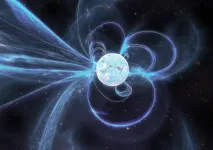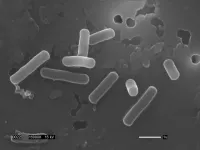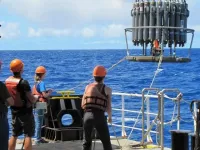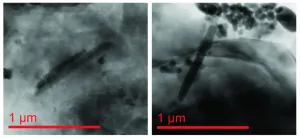Astronomers spot bizarre activity from one of the strongest magnets in the Universe
2021-02-02
(Press-News.org) Astronomers from the ARC Centre of Excellence for Gravitational Wave Discovery (OzGrav) and CSIRO have just observed bizarre, never-seen-before behaviour from a 'radio-loud' magnetar--a rare type of neutron star and one of the strongest magnets in the Universe.
Their new findings, published today in the Monthly Notices of the Royal Astronomical Society (MNRAS), suggest magnetars have more complex magnetic fields than previously thought - which may challenge theories of how they are born and evolve over time.
Magnetars are a rare type of rotating neutron star with some of the most powerful magnetic fields in the Universe. Astronomers have detected only thirty of these objects in and around the Milky Way--most of them detected by X-ray telescopes following a high-energy outburst.
However, a handful of these magnetars have also been seen to emit radio pulses similar to pulsars--the less magnetic cousins of magnetars that produce beams of radio waves from their magnetic poles. Tracking how the pulses from these 'radio-loud' magnetars change over time offers a unique window into their evolution and geometry.
In March 2020, a new magnetar named Swift J1818.0-1607 (J1818 for short) was discovered after it emitted a bright X-ray burst. Rapid follow-up observations detected radio pulses originating from the magnetar. Curiously, the appearance of the radio pulses from J1818 were quite different to those seen from other radio-loud magnetars.
Most radio pulses from magnetars maintain a consistent brightness across a wide range of observing frequencies. However, the pulses from J1818 were much brighter at low frequencies than high frequencies - similar to what is seen in pulsars, another more common type of radio-emitting neutron star.
In order to better understand how J1818 would evolve over time, a team led by scientists from the ARC Centre of Excellence for Gravitational Wave Discovery (OzGrav) observed it eight times using the CSIRO Parkes radio telescope (also known as Murriyang) between May and October 2020.
During this time, they found the magnetar underwent a brief identity crisis: in May it was still emitting the unusual pulsar-like pulses that had been detected previously; however, by June it had started flickering between a bright and a weak state. This flickering behaviour reached a peak in July where they saw it flicking back and forth between emitting pulsar-like and magnetar-like radio pulses.
"This bizarre behaviour has never been seen before in any other radio-loud magnetar," explains study lead author and Swinburne University/CSIRO PhD student Marcus Lower. "It appears to have only been a short-lived phenomenon as by our next observation it had settled permanently into this new magnetar-like state."
The scientists also looked for pulse shape and brightness changes at different radio frequencies and compared their observations to a 50-year-old theoretical model. This model predicts the expected geometry of a pulsar, based on the twisting direction of its polarised light.
"From our observations, we found that the magnetic axis of J1818 isn't aligned with its rotation axis," says Lower.
"Instead, the radio-emitting magnetic pole appears to be in its southern hemisphere, located just below the equator. Most other magnetars have magnetic fields that are aligned with their spin axes or are a little ambiguous."
"This is the first time we have definitively seen a magnetar with a misaligned magnetic pole."
Remarkably, this magnetic geometry appears to be stable over most observations. This suggests any changes in the pulse profile are simply due to variations in the height the radio pulses are emitted above the neutron star surface. However, the August 1st 2020 observation stands out as a curious exception.
"Our best geometric model for this date suggests that the radio beam briefly flipped over to a completely different magnetic pole located in the northern hemisphere of the magnetar," says Lower.
A distinct lack of any changes in the magnetar's pulse profile shape indicate the same magnetic field lines that trigger the 'normal' radio pulses must also be responsible for the pulses seen from the other magnetic pole.
The study suggests this is evidence that the radio pulses from J1818 originate from loops of magnetic field lines connecting two closely spaced poles, like those seen connecting the two poles of a horseshoe magnet or sunspots on the Sun. This is unlike most ordinary neutron stars which are expected to have north and south poles on opposite sides of the star that are connected by a donut-shaped magnetic field.
This peculiar magnetic field configuration is also supported by an independent study of the X-rays pulses from J1818 that were detected by the NICER telescope on board the International Space Station. The X-rays appear to come from either a single distorted region of magnetic field lines that emerge from the magnetar surface or two smaller, but closely spaced, regions.
These discoveries have potential implications for computer simulations of how magnetars are born and evolve over long periods of time, as more complex magnetic field geometries will change how quickly their magnetic fields are expected to decay over time. Additionally, theories that suggest fast radio bursts can originate from magnetars will have to account for radio pulses potentially originating from multiple active sites within their magnetic fields.
Catching a flip between magnetic poles in action could also afford the first opportunity to map the magnetic field of a magnetar.
"The Parkes telescope will be watching the magnetar closely over the next year" says scientist and study co-author Simon Johnston, from the CSIRO Astronomy and Space Science.
INFORMATION:
[Attachments] See images for this press release:

ELSE PRESS RELEASES FROM THIS DATE:
2021-02-02
HOUSTON-(Feb. 1, 2021) - Houston Methodist researchers have developed a mathematical model to predict how specific cancers will respond to immunotherapy treatments, thus enhancing chances for successful treatments from a wide variety of cancer-immunotherapy drug combinations. The results were published last month in Nature Biomedical Engineering in collaboration with researchers at MD Anderson Cancer Center.
Immunotherapy activates patients' immune systems to recognize and attack their cancers, leading to higher, more targeted kill rates and fewer side effects than chemotherapy, radiation and other therapies. While this technology is a significant advance in fighting cancer, it works only with some cancer ...
2021-02-02
Oak Brook, IL - The February edition of SLAS Discovery is a Special Issue on Hit Discovery Methodologies edited by Mark Wigglesworth, Ph.D., (Medicines Discovery Catapult, Stockport, EN, UK) and Peter Hodder, Ph.D. (Amgen, Thousand Oaks, CA, USA).
The focus of this Special Issue is to highlight the use of hit discovery methodologies and technologies and their usage in both small molecule and large molecule drug discovery. The February issue exemplifies how technologies, both new and existing, have been applied successfully to find hits.
Additionally, the issue houses a list of the most downloaded articles from SLAS journals, many of which ...
2021-02-02
Las Vegas, Nev. (Monday, Feb. 1, 2021) - In the summer of 2019, Desert Research Institute (DRI) scientist Rosemary Carroll, Ph.D., waited for the arrival of the North American Monsoon, which normally brings a needed dose of summer moisture to the area where she lives in Crested Butte, Colo. - but for the fourth year in a row, the rains never really came.
"2019 had just a horrendous monsoon," Carroll said. "Just the weakest monsoon. And we'd had a few years of weak monsoons before that, which had really gotten me wondering, how important is the monsoon to late summer streamflow here in the Upper Colorado River basin? And how do monsoons influence the following year's streamflow?"
Working in partnership with colleagues ...
2021-02-02
Oak Brook, IL - The February edition of SLAS Technology is a special collection of articles focused on "Artificial Intelligence in Process Automation" by Guest Editor Cenk Ündey, Ph.D. (Amgen, Thousand Oaks, CA, USA).
This SLAS Technology special collection targets the use of artificial intelligence (AI) techniques and technologies as applied specifically to drug discovery, automated gene editing and machine learning. As AI becomes increasingly more prevalent in research, medicine and even everyday life, laboratory automation has gone beyond hardware advancements toward new levels ...
2021-02-01
Risk for a severe form of retinopathy of prematurity, which can cause blindness in extremely premature babies, was halved when the newborns were given a new supplement combining various fatty acids. This was shown in a Swedish study led from the University of Gothenburg.
The study, now published in JAMA Pediatrics, is described as groundbreaking in its field. It documents a clear fall in retinopathy of prematurity (ROP) among extremely premature (EP) infants (born before 28 weeks' gestation), whose retinal blood vessels are not fully developed. The condition can cause ...
2021-02-01
When the body's immune response to an infection gets out of control, the result can be sepsis, a life-threatening condition in which an overwhelming inflammatory response can lead rapidly to failure of multiple organs and death.
In a new study, researchers at UC Santa Cruz have identified a long noncoding RNA (lncRNA) molecule that regulates the expression of pro-inflammatory genes in immune system cells called macrophages and affects the susceptibility of mice to septic shock.
This lncRNA, called GAPLINC, was previously studied for its role in cancer, but it turns out to be the most highly expressed lncRNA in macrophages, which play a central role in inflammation. ...
2021-02-01
A previously unknown root trait allows some cereal plants to grow deeper roots capable of punching through dry, hard, compacted soils, according to Penn State researchers, who suggest that harnessing the inherited characteristic could lead to crops better able to deal with a changing climate.
"This discovery bodes well for American and global agriculture because the trait helps corn, wheat and barley grow deeper roots, which is important for drought tolerance, nitrogen efficiency and carbon sequestration," said Jonathan Lynch, distinguished professor in plant science. "Breeding for this trait should be helpful in developing new crops for climate mitigation."
Called multiseriate cortical sclerenchyma by the researchers -- or MCS -- the phenotype is ...
2021-02-01
New research from North Carolina State University reveals that probiotic Lactobacillus bacteria use enzymes situationally to manipulate bile acids and promote their own survival in the gut. These findings further elucidate the complicated relationship between bile acids and gut bacteria and could eventually enable researchers to design lactobacilli with therapeutic properties, thereby engineering a healthier human gut environment.
Bile acids are key players in digestion and overall gut health. Produced in the liver and released after we eat, these acids not ...
2021-02-01
Just as plants and animals on land are keenly attuned to the hours of sunlight in the day, life in the oceans follows the rhythms of the day, the seasons and even the moon. A University of Washington study finds the biological light switches that make this possible.
Single-celled organisms in the open ocean use a diverse array of genetic tools to detect light, even in tiny amounts, and respond, according to a study published Feb. 1 in the Proceedings of the National Academy of Sciences.
"If you look in the ocean environment, all these different organisms have this day-night cycle. They are very in tune with each other, even as they get moved around. How do they know when it's day? How do they know when it's night?" said lead ...
2021-02-01
There are fossils, found in ancient marine sediments and made up of no more than a few magnetic nanoparticles, that can tell us a whole lot about the climate of the past, especially episodes of abrupt global warming. Now, researchers including doctoral student Courtney Wagner and associate professor Peter Lippert from the University of Utah, have found a way to glean the valuable information in those fossils without having to crush the scarce samples into a fine powder. Their results are published in Proceedings of the National Academy of Sciences.
"It's so fun to be a part of a discovery like this, something that can be used ...
LAST 30 PRESS RELEASES:
[Press-News.org] Astronomers spot bizarre activity from one of the strongest magnets in the Universe







